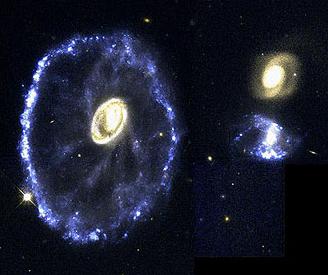Galaxy Harassment
Galaxies are generally not found in isolation. Most of them are surrounded by a swarm of satellite galaxies and are often embedded in larger aggregates such as galaxy groups or clusters. In these environments, interactions between galaxies are not uncommon and in general, can be divided into two basic types: mergers and ‘fly-bys’. Interactions involving high-speed fly-bys are often referred to as galaxy ‘harassment’.
Harassment can disturb, or even radically change, the morphologies of the galaxies involved, often inducing new bursts of star formation. Asymmetrical galaxies, disturbed galaxies, warps, bars and tidal tails can all be produced through galaxy harassment.
For example, the Cartwheel galaxy (right) was similar to our own Milky Way until quite recently, when a smaller galaxy (probably one of the galaxies on the right) ploughed through its centre. This harassment has created spokes of stars and gas, and a bright blue ring of new star formation resulting in a wheel-like appearance for the galaxy and its descriptive name.
Research into the nature of galaxies is aided by the study of harassed galaxies for two reasons:
- the effects of harassment (tidal tails, asymmetry, warps etc) can often be used to probe the distribution of matter (both visible and dark) within the galaxies involved.
- current research suggests that harassment, and other interactions, may play an important role in shaping the evolution of galaxies.
Study Astronomy Online at Swinburne University
All material is © Swinburne University of Technology except where indicated.


